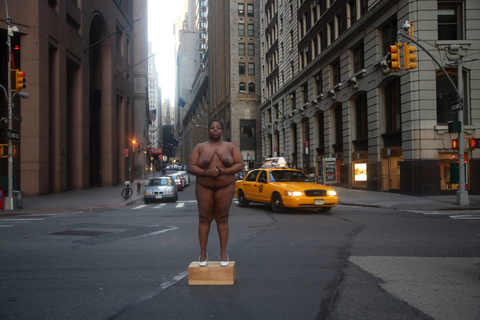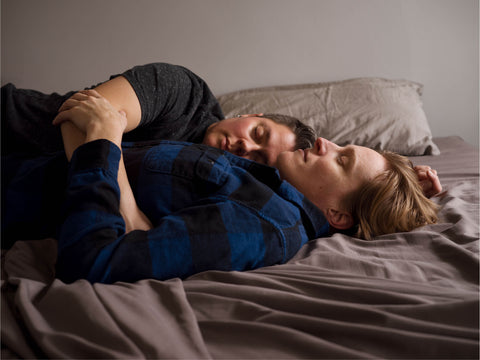
© Deana Lawson, self-portrait (taken by Dru Donovan), 2012
DW: I love the way you describe your family. It’s familiar to me, and maybe that’s why we are friends. I grew up with aunts who were fabulous dressers, sang in the choir, enjoyed life. My father was also the family photographer. And you and my son, Hank Willis Thomas, have a lot in common, in terms of going to the family albums and looking at photographs.
How did the city of Rochester—as the home of the Eastman Kodak company—impact you and your art?
DL: Kodak had a huge impact on my family. My grandmother cleaned house for George Eastman. My mother was an administrative assistant at Kodak for thirty-nine years, and I have an aunt who worked at Kodak too. My dad was on the Kodak baseball team when he was a preteen. So there was a sort of loyalty to Kodak where I was from. My mom would always say: “Don’t buy Fuji—you have to buy Kodak.” I didn’t know when I was growing up that I was going to be a photographer or an artist, but the aesthetic of Kodak analog materials appealed to me. Even my father’s old prints are beautiful: just so rich with color and strong warm tones.
DW: When I was an undergraduate, I learned about the “Shirley card” [a card produced by Kodak in the 1950s showing a color photograph of a white woman in a fur stole; it was used for decades by photographers and processors as a standard reference for calibrating skin tones, shadows, and light]. Growing up in Rochester with your father sending work out, was the Shirley card part of your discussions?
DL: I learned about the Shirley card in graduate school in the early 2000s, so this wasn’t part of our discussions while I was growing up in Rochester. When my father was photographing in the 1970s to the late 1990s, he was making pictures and videos with the tools he had available, and with- out access to elevated discussions of the history of photography within the academy. Picture making was a way for my father to celebrate his relationships with immediate and extended family and friends. Later, I would come to this fascinating and disturbing knowledge of the Shirley card and how Kodak materials were not calibrated for Black and brown skin complexions. Yet, ironically, my father made it work: his photographs came out beautiful and represented brown skin tones in a lush way, which would later serve as a foundation for how I wanted skin to read on a negative, and then ultimately in the print.
When I moved to New York in 2008, I met Louis Mendes, one of the most prolific self-taught photographers I’ve ever encountered. I visited his small apartment in Harlem, on 127th Street, and observed his exquisite depictions of Black women and families, and the beautiful prints he made of his commercial portraits. I followed him around New York for years and invested in a [Graflex] Crown Graphic camera. We went to Coney Island, concerts in Harlem, graduations, and Easter Sundays. Louis Mendes was my third education, outside the academy. He told me: “You have to make this film work for you. Rig up your camera, do whatever you need to do to make it bend to your will.”
DW: I’m fascinated with your Rochester history. Of course, Frederick Douglass lived in Rochester for most of his life. Did his historical presence there have an impact on you as you were growing up?
DL: Frederick Douglass’s legacy was felt in ways that I witnessed folks live embodied lives in Rochester. When I look at the portraits made of Douglass throughout his life, his gaze and stature show self-possession and an unwavering confidence with the camera. His gaze represents not only a vision of himself as a Black man of excellence, but a vision of photography itself—a revolutionary medium capable of expanding the nation’s racial imaginary. Douglass’s prophetic sentiments on photography and progress, uttered during his speeches in the mid-nineteenth century, were seminal. I believe a part of my work is a manifestation of those seeds he planted in Rochester over a century ago.
Frederick Douglass’s first wife, Anna Murray Douglass, also holds great value in my photographic genealogy. Would we be speaking of Frederick Douglass today if it wasn’t for the bravery, encouragement, and support that Anna Murray Douglass provided for Douglass’s escape from slavery? It was Anna Murray’s income from menial labor that helped to support their family when Douglass began his career delivering speeches. We also know that Anna Murray established their family home in Rochester as a safe haven for the Underground Railroad. Her loyalty and sacrifice for the movement are the endearing qualities that remind me of the women in my family, and the ways they distribute care to their communities.
DW: I know you went to the Rhode Island School of Design for grad school. We first met at RISD, when I gave a lecture there.
DL: I will never forget it! I was so captivated, because I had read your work, and I remember asking you something like: “How can the Black female be the center of philosophical and existential thought? And how do we make that change via photography?” And I remember you said something like: “You know, I don’t have the answer, but I think it’s a good question.” So I just kept going with that question.
At the time when we met at RISD, I was photographing my family. I would go back to Rochester and take pictures and come back to school and print them large. But I was starting to break off from only photographing my family. I realized that I wouldn’t always be able to go back to Rochester to make work. I had to expand this idea of family if I was going to move forward in the world.
Excerpted from Deana Lawson and Deborah Willis’s conversation in Deana Lawson ed. by Peter Eleey and Eva Respini
Faux leather bound hardback with printed tip in and embossed text.
24 x 29cm, 144 pages
ISBN 978-1-912339-98-3
November 2021
€40 £35 $40
Add to cart





